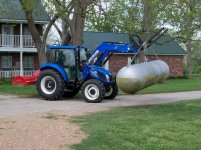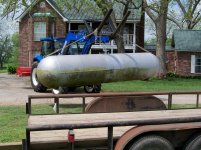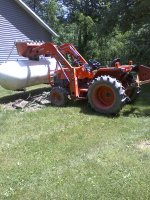drajj5
Gold Member
I did some searching on this site regarding FEL lifting, and did something that you are not supposed to do.
I recently purchased the property next to mine and needed to move the Propane Tank from that home to mine. Today was the day of the move.... Tractor that I own is a Mahindra Max 28 to make the move. Not too far maybe 1/2 mile between where it was and where it needs to go. I realize that this is probably not the right tool for the job but must suffice as it is the only piece of equipment I own- lame excuse I know; there is redneck blood in me!
I Lifted the tank with a chain wrapped around the bucket attached to the welded hooks on either end of the tank. I moved it maybe 5 foot and could not control the swaying of the tank and any bump in the sloped gravel road gave me the heeby jeebies. So I had to rethink it; took 2 large ratchet straps and used the bucket to cradle the tank and secured it firmly to the bucket. The bucket on the tractor is small compared to the size of the tank - another clue that what I was doing was stupid.
Now to the meat of the post, The loader was able to pick it and transport it to my home using the strap technique. Curling the load proved to be more than the loader could handle; the loader arms would lift it fine ( the loader controls were super sensitive with that much weight). The bucket roll cylinders did hold but were unresponsive to curling the tank.
So the question- I always thought the bucket curl would be the, "strongest" part of the loader. I know that the loader arms do more work but thought; curl force would exceed the loader arms as its only job is- working the bucket roll. I am pleased it did the job... But learned that the cylinders that work the bucket are not a stout as I thought.
I always assumed that (breakout force) was bucket curl, which is typically marketed with a (higher capacity than the loader) Am I mistaken?
I recently purchased the property next to mine and needed to move the Propane Tank from that home to mine. Today was the day of the move.... Tractor that I own is a Mahindra Max 28 to make the move. Not too far maybe 1/2 mile between where it was and where it needs to go. I realize that this is probably not the right tool for the job but must suffice as it is the only piece of equipment I own- lame excuse I know; there is redneck blood in me!
I Lifted the tank with a chain wrapped around the bucket attached to the welded hooks on either end of the tank. I moved it maybe 5 foot and could not control the swaying of the tank and any bump in the sloped gravel road gave me the heeby jeebies. So I had to rethink it; took 2 large ratchet straps and used the bucket to cradle the tank and secured it firmly to the bucket. The bucket on the tractor is small compared to the size of the tank - another clue that what I was doing was stupid.
Now to the meat of the post, The loader was able to pick it and transport it to my home using the strap technique. Curling the load proved to be more than the loader could handle; the loader arms would lift it fine ( the loader controls were super sensitive with that much weight). The bucket roll cylinders did hold but were unresponsive to curling the tank.
So the question- I always thought the bucket curl would be the, "strongest" part of the loader. I know that the loader arms do more work but thought; curl force would exceed the loader arms as its only job is- working the bucket roll. I am pleased it did the job... But learned that the cylinders that work the bucket are not a stout as I thought.
I always assumed that (breakout force) was bucket curl, which is typically marketed with a (higher capacity than the loader) Am I mistaken?



